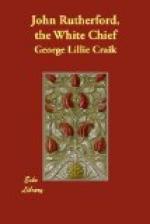The stick with which the chisel is struck is occasionally formed into a broad blade at one end, which is applied to wipe away the blood. The tincture is said to be sometimes obtained from the juice of a particular tree.
Rutherford has forgotten to mention that, before the cutting has begun the figure is traced out upon the place; this appears to be always done in New Zealand as well as elsewhere, a piece of burnt stick or red earth being, according to Savage,[V] used for the purpose.
Some are tattooed at eight or ten years of age; but a young man is accounted very effeminate who reaches his twentieth year without having undergone the operation. Marsden told one of the chiefs, King George, as he was called, that he must not tattoo his nephew Racow,[W] who was a very fine-looking youth, with a dignified, open, and placid countenance, remarking that it would quite disfigure his face; “but he laughed at my advice,” says Marsden, “and said he must be tattooed, as it would give him a noble, masculine, and warlike appearance; that he would not be fit for his successor with a smooth face; the New Zealanders would look on him merely as a woman if he was not tattooed.”
Savage says that a small spiral figure on each side of the chin, a semi-circular figure over each eyebrow, and two, or sometimes three, lines on each lip, are all the tattooing the New Zealand women are required to submit to.
Rutherford’s account is that they have a figure tattooed on the chin resembling a crown turned upside down; that the inside of their lips is also tattooed, the figures here appearing of a blue colour; and that they have also a mark on each side of the mouth resembling a candlestick, as well as two stripes about an inch long on the forehead, and one on each side of the nose. Their decorations of this description, as well as of the other sex, are no doubt different in different parts of the country.
“With respect to the amocos,” says Cook in his First Voyage, “every different tribe seemed to have a different custom; for all the men in some canoes seemed to be almost covered with it, and those in others had scarcely a stain, except on the lips, which were black in all of them, without a single exception.”
Rutherford states that in the part of the country where he was, the men were commonly tattooed on their face, hips, and bodies, and some as low as the knee. None were allowed to be tattooed on the forehead, chin, and upper lip, except the very greatest among the chiefs. The more they are tattooed, he adds, the more they are honoured. The priests, Savage says, have only a small square patch of tattooing over the right eye.




